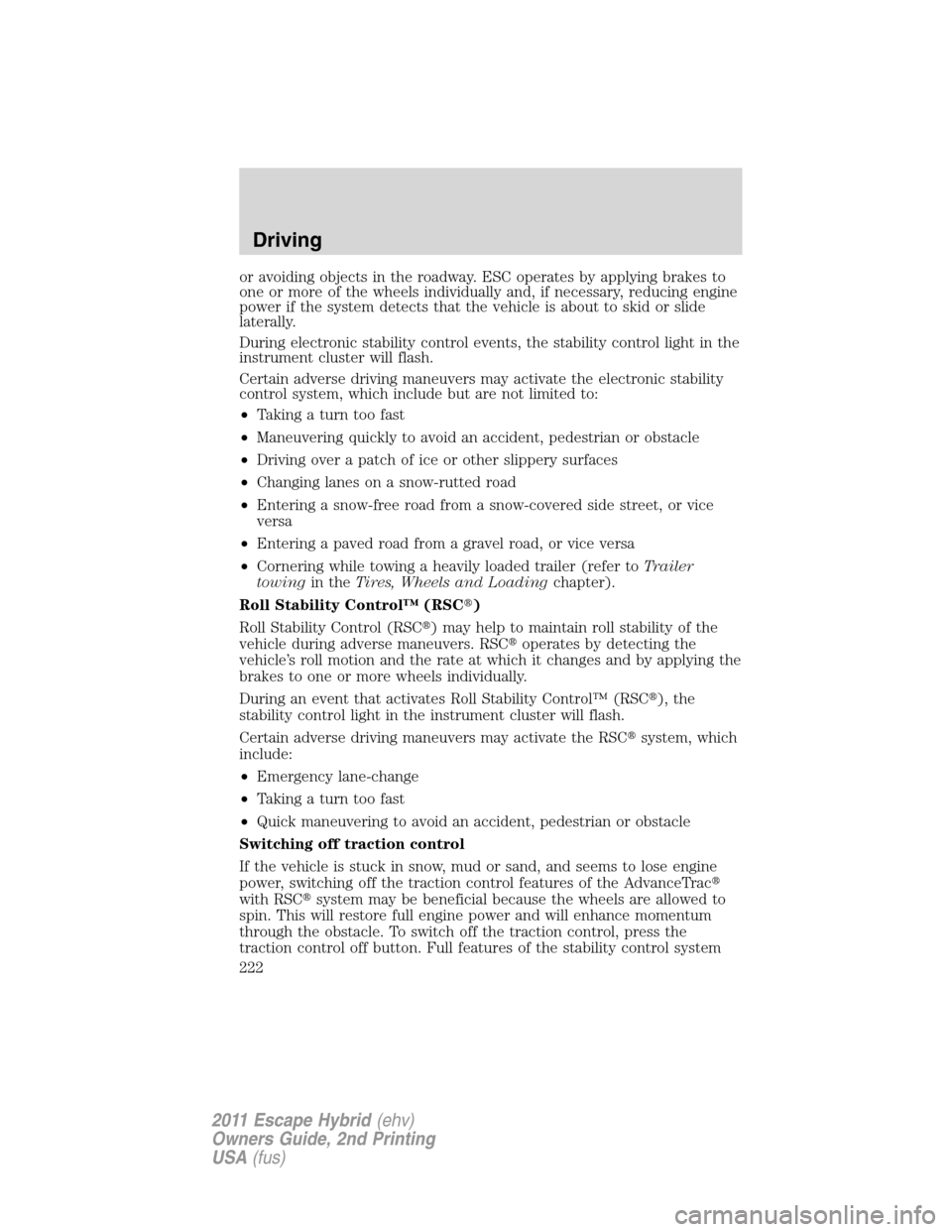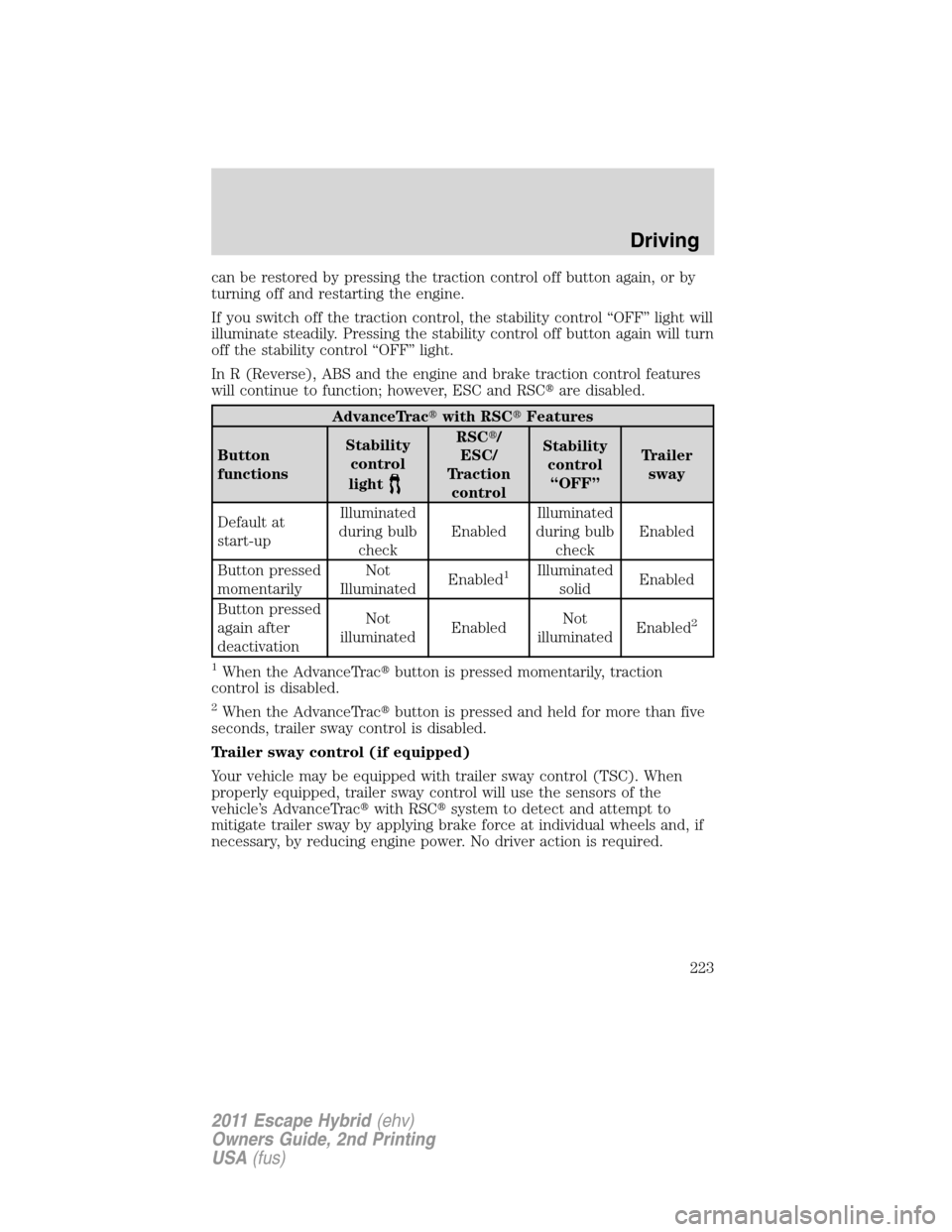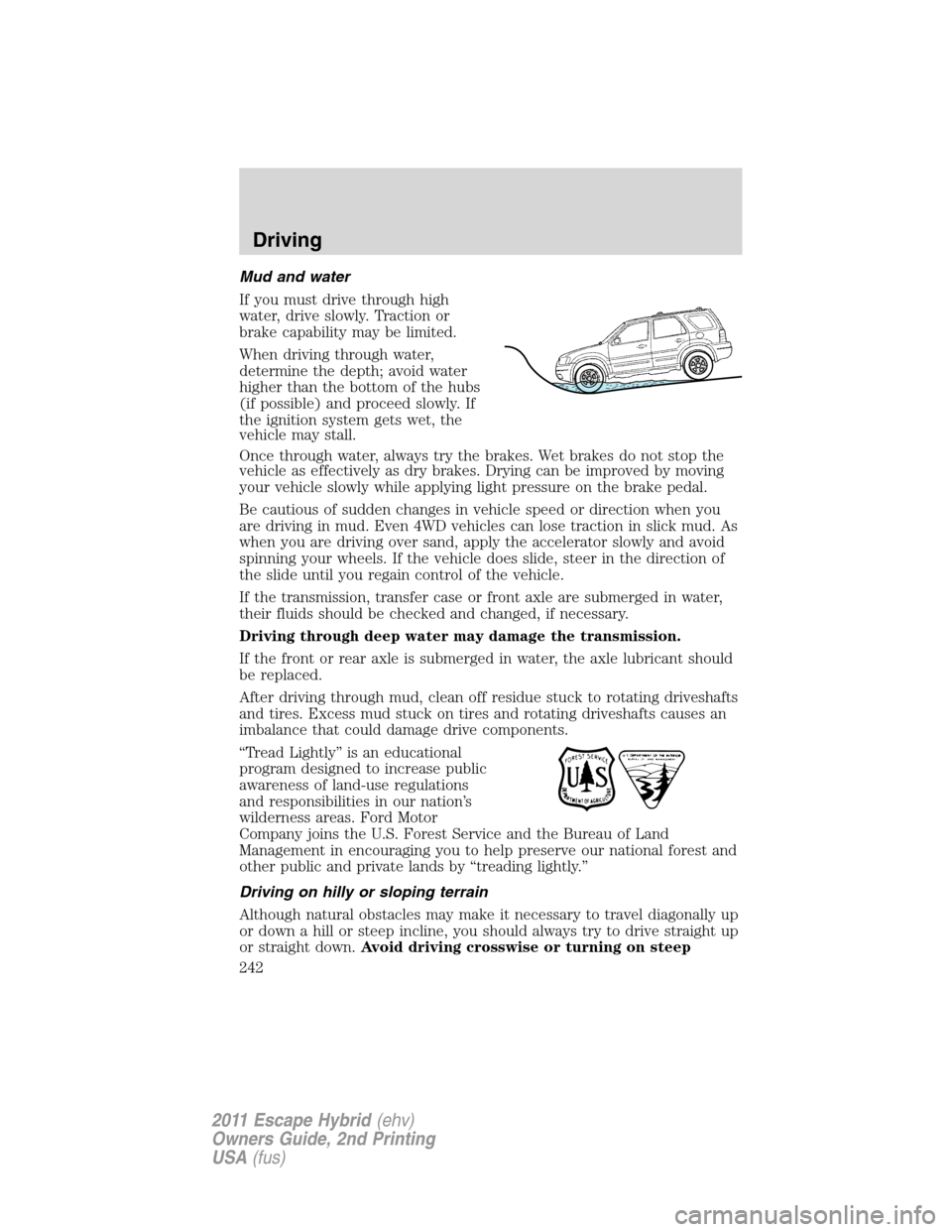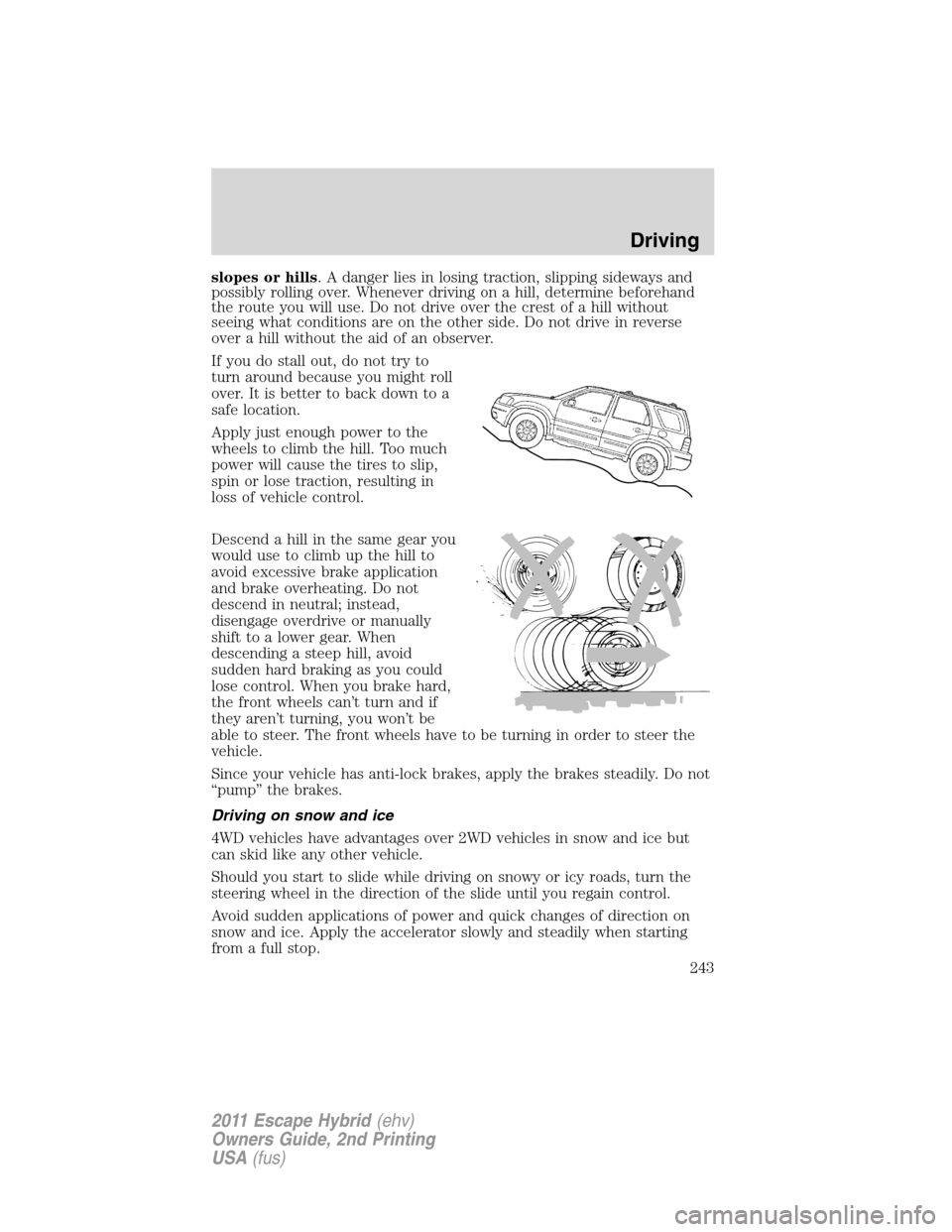Page 222 of 363

or avoiding objects in the roadway. ESC operates by applying brakes to
one or more of the wheels individually and, if necessary, reducing engine
power if the system detects that the vehicle is about to skid or slide
laterally.
During electronic stability control events, the stability control light in the
instrument cluster will flash.
Certain adverse driving maneuvers may activate the electronic stability
control system, which include but are not limited to:
•Taking a turn too fast
•Maneuvering quickly to avoid an accident, pedestrian or obstacle
•Driving over a patch of ice or other slippery surfaces
•Changing lanes on a snow-rutted road
•Entering a snow-free road from a snow-covered side street, or vice
versa
•Entering a paved road from a gravel road, or vice versa
•Cornering while towing a heavily loaded trailer (refer toTrailer
towingin theTires, Wheels and Loadingchapter).
Roll Stability Control™ (RSC�)
Roll Stability Control (RSC�) may help to maintain roll stability of the
vehicle during adverse maneuvers. RSC�operates by detecting the
vehicle’s roll motion and the rate at which it changes and by applying the
brakes to one or more wheels individually.
During an event that activates Roll Stability Control™ (RSC�), the
stability control light in the instrument cluster will flash.
Certain adverse driving maneuvers may activate the RSC�system, which
include:
•Emergency lane-change
•Taking a turn too fast
•Quick maneuvering to avoid an accident, pedestrian or obstacle
Switching off traction control
If the vehicle is stuck in snow, mud or sand, and seems to lose engine
power, switching off the traction control features of the AdvanceTrac�
with RSC�system may be beneficial because the wheels are allowed to
spin. This will restore full engine power and will enhance momentum
through the obstacle. To switch off the traction control, press the
traction control off button. Full features of the stability control system
Driving
222
2011 Escape Hybrid(ehv)
Owners Guide, 2nd Printing
USA(fus)
Page 223 of 363

can be restored by pressing the traction control off button again, or by
turning off and restarting the engine.
If you switch off the traction control, the stability control “OFF” light will
illuminate steadily. Pressing the stability control off button again will turn
off the stability control “OFF” light.
In R (Reverse), ABS and the engine and brake traction control features
will continue to function; however, ESC and RSC�are disabled.
AdvanceTrac�with RSC�Features
Button
functionsStability
control
light
RSC�/
ESC/
Traction
controlStability
control
“OFF”Trailer
sway
Default at
start-upIlluminated
during bulb
checkEnabledIlluminated
during bulb
checkEnabled
Button pressed
momentarilyNot
IlluminatedEnabled
1Illuminated
solidEnabled
Button pressed
again after
deactivationNot
illuminatedEnabledNot
illuminatedEnabled
2
1
When the AdvanceTrac�button is pressed momentarily, traction
control is disabled.
2When the AdvanceTrac�button is pressed and held for more than five
seconds, trailer sway control is disabled.
Trailer sway control (if equipped)
Your vehicle may be equipped with trailer sway control (TSC). When
properly equipped, trailer sway control will use the sensors of the
vehicle’s AdvanceTrac�with RSC�system to detect and attempt to
mitigate trailer sway by applying brake force at individual wheels and, if
necessary, by reducing engine power. No driver action is required.
Driving
223
2011 Escape Hybrid(ehv)
Owners Guide, 2nd Printing
USA(fus)
Page 242 of 363

Mud and water
If you must drive through high
water, drive slowly. Traction or
brake capability may be limited.
When driving through water,
determine the depth; avoid water
higher than the bottom of the hubs
(if possible) and proceed slowly. If
the ignition system gets wet, the
vehicle may stall.
Once through water, always try the brakes. Wet brakes do not stop the
vehicle as effectively as dry brakes. Drying can be improved by moving
your vehicle slowly while applying light pressure on the brake pedal.
Be cautious of sudden changes in vehicle speed or direction when you
are driving in mud. Even 4WD vehicles can lose traction in slick mud. As
when you are driving over sand, apply the accelerator slowly and avoid
spinning your wheels. If the vehicle does slide, steer in the direction of
the slide until you regain control of the vehicle.
If the transmission, transfer case or front axle are submerged in water,
their fluids should be checked and changed, if necessary.
Driving through deep water may damage the transmission.
If the front or rear axle is submerged in water, the axle lubricant should
be replaced.
After driving through mud, clean off residue stuck to rotating driveshafts
and tires. Excess mud stuck on tires and rotating driveshafts causes an
imbalance that could damage drive components.
“Tread Lightly” is an educational
program designed to increase public
awareness of land-use regulations
and responsibilities in our nation’s
wilderness areas. Ford Motor
Company joins the U.S. Forest Service and the Bureau of Land
Management in encouraging you to help preserve our national forest and
other public and private lands by “treading lightly.”
Driving on hilly or sloping terrain
Although natural obstacles may make it necessary to travel diagonally up
or down a hill or steep incline, you should always try to drive straight up
or straight down.Avoid driving crosswise or turning on steep
Driving
242
2011 Escape Hybrid(ehv)
Owners Guide, 2nd Printing
USA(fus)
Page 243 of 363

slopes or hills. A danger lies in losing traction, slipping sideways and
possibly rolling over. Whenever driving on a hill, determine beforehand
the route you will use. Do not drive over the crest of a hill without
seeing what conditions are on the other side. Do not drive in reverse
over a hill without the aid of an observer.
If you do stall out, do not try to
turn around because you might roll
over. It is better to back down to a
safe location.
Apply just enough power to the
wheels to climb the hill. Too much
power will cause the tires to slip,
spin or lose traction, resulting in
loss of vehicle control.
Descend a hill in the same gear you
would use to climb up the hill to
avoid excessive brake application
and brake overheating. Do not
descend in neutral; instead,
disengage overdrive or manually
shift to a lower gear. When
descending a steep hill, avoid
sudden hard braking as you could
lose control. When you brake hard,
the front wheels can’t turn and if
they aren’t turning, you won’t be
able to steer. The front wheels have to be turning in order to steer the
vehicle.
Since your vehicle has anti-lock brakes, apply the brakes steadily. Do not
“pump” the brakes.
Driving on snow and ice
4WD vehicles have advantages over 2WD vehicles in snow and ice but
can skid like any other vehicle.
Should you start to slide while driving on snowy or icy roads, turn the
steering wheel in the direction of the slide until you regain control.
Avoid sudden applications of power and quick changes of direction on
snow and ice. Apply the accelerator slowly and steadily when starting
from a full stop.
Driving
243
2011 Escape Hybrid(ehv)
Owners Guide, 2nd Printing
USA(fus)
Page 255 of 363

Fuse/Relay
LocationFuse Amp
RatingProtected Circuits
7 15A* Liftgate latch
8 5A* Traction battery control module
9 50A** Brake control module
10 30A** Front wipers
11 — Not used
12 40A** Blower motor
13 — Not used
14 10A* Heater/Coolant pump
15 50A** Traction battery control module (TBCM)
16 40A** Cooling fan 1
17 40A** Cooling fan 2
18 50A** Brake control module solenoid
19 30A** Power seats
20 — Not used
21A — Rear defroster relay
21B — Ignition relay
21C — Blower relay
21D — PCM relay
22 15A* Ignition coils
23 15A* Fuel injectors
24 10A* Transmission control module
25 5A* TBCM
26 20A* Fuel pump, TBCM
27 10A* PCM (general powertrain components
malfunction indicator lamp), Heater
pump relay, Motor electronics coolant
pump relay, Electronic A/C compressor
28 15A* Universal exhaust gas oxygen (UEGO)
sensor, PCM – emission related
powertrain components malfunction
indicator lamp
29 15A* PCM power
Roadside Emergencies
255
2011 Escape Hybrid(ehv)
Owners Guide, 2nd Printing
USA(fus)